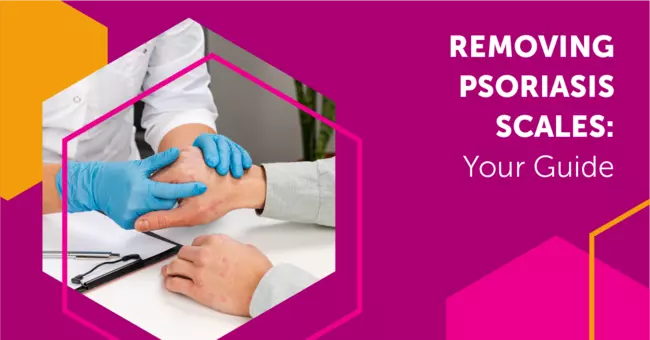
Quick Links
Resources
About MyPsoriasisTeam
Powered By








Plaque psoriasis causes an overproduction of skin cells that adhere to the top of the skin, resulting in silvery scales of dead skin that can often be gently removed at home. Aside from being itchy, psoriasis scales also flake off and shed, which can be messy. Psoriasis scales can resemble large flakes of dandruff or look like peeling skin after a sunburn.
For many people with psoriasis, scales are a source of physical and emotional discomfort. Scales are considered one of the most burdensome symptoms of plaque psoriasis.
MyPsoriasisTeam members often discuss scales, as they seek remedies for removing them:
Learn more about managing psoriasis itching.
The careful removal of psoriasis scales can help reduce itch and improve skin’s appearance. Before attempting to remove scales yourself, talk to your doctor about your particular skin condition to find out if home removal is appropriate for you.
To remove scales, be sure you have the appropriate products on hand. Removing psoriasis scales can be done safely without damaging skin by using products with substances that help chemically and physically separate and lift scales away from psoriasis plaques.

Compounds used to remove psoriasis scales are known as keratolytics, or keratolytic agents. Keratolytics, which soften and separate the outer layer of skin, are used for treating psoriasis and other skin diseases, such as eczema and seborrheic dermatitis. Keratolytics, sometimes called scale lifters, can help peel away scales and reduce the thickening of plaques without damaging skin.
Salicylic acid is considered the most effective keratolytic agent, but high amounts of salicylic acid can be harmful to skin. Safe concentrations of salicylic acid can be found in many products created for the treatment of psoriasis. Other keratolytics, such as urea and lactic acid, are also used for lifting psoriasis scales off the skin. These ingredients can be found in prescription topical medications and in a range of over-the-counter products, such as shampoos, moisturizers, and bath solutions.
There are several other ingredients that are beneficial for both the prevention and removal of scales, including:
Many of these ingredients can be found in items featured in the National Psoriasis Foundation’s directory of products with a Seal of Recognition for treating psoriasis. These products are considered safe for people with psoriasis and do not contain irritants known to cause flare-ups.
Other products not listed in the directory may also be appropriate for lifting scales. Some people use coconut oil, olive oil, or other natural oils. Ask your dermatologist if you have questions about which products to use.
The removal of psoriasis scales is sometimes referred to as exfoliation, which is the process of removing dead skin cells. Unlike some exfoliating, which uses abrasive scrubbing, the removal of psoriasis scales requires gentle care — allowing the chemicals to do the exfoliating. Set aside time and do not rush the process. One way to loosen scales is to start with a 15-minute bath in lukewarm water and a bath solution that has a keratolytic agent.
Hot water can dry out and irritate psoriasis lesions, and it should be avoided. A lukewarm shower can also loosen scales. Use a soft washcloth, pumice stone, or your hands to gently clean your skin and remove scales while bathing. An abrasive scrubber like a loofah sponge is not recommended, as it may injure your skin and cause it to flare and bleed.
After bathing, moisturize your skin well with a cream, oil, or lotion, and use an emollient or ointment with a keratolytic agent, like salicylic acid. As scales lift off the skin, do not pick at them.
For scales from scalp psoriasis, frequent shampooing with a product that contains salicylic acid, coal tar, or another keratolytic can help reduce flaking. Some people use oil on their scalp and gently comb out scales. Putting olive oil on your scalp prior to shampooing may help loosen the scale there. There are also prescription medications that combine anti-inflammatory steroids and oil, for use on the body and scalp.
If you have excessive scaling, talk with your doctor about changing your treatment plan to find a medication that better treats your psoriasis and reduces the scale.
MyPsoriasisTeam members sometimes share their experiences in removing scales. ”Yesterday I bought some Little Angels Nappy Cream,” a member wrote. “I had a long soak in the bath and removed as many scales as I could. I then generously applied it on my body from head to toe, even on my face. I ended up using half a tube, and it has seemed to work great with the itching.”
One MyPsoriasisTeam member offered this tip for removing scales on the scalp: “Try using some scalp oil (available at the drugstore). Put it on wet hair, cover with shower cap, leave it on overnight, and wash hair the next morning. Do this every other night for about a week, then once a week. Should help.”
Picking at your skin risks injury, bleeding, and infection. Sometimes it can be hard to resist picking at scales, but the outcome can leave skin in worse shape. People with psoriasis are vulnerable to the Koebner phenomenon, in which a skin injury causes psoriasis lesions in places that were previously clear. A skin injury can be a bruise, a cut, or damage from picking at psoriasis scales.
“Sometimes I go crazy and pick and pull the scales off until it bleeds badly,” said a MyPsoriasisTeam member. “I am a compulsive picker, and I pay for it dearly. Don't pick if you can help it.”

Maintaining your treatment plan is essential for managing symptoms and reducing scales. Adhering to a treatment plan — whether home skin care and regular moisturizing, topical treatments like corticosteroids, phototherapy, or systemic medication (such as biologics or methotrexate) — will help control psoriasis symptoms.
Be sure to ask your doctor for advice before attempting to remove scales, if you are unsure how to do so safely.
MyPsoriasisTeam is the social network for people with psoriasis and their loved ones. On MyPsoriasisTeam, more than 88,000 members come together to ask questions, give advice, and share their stories with others who understand life with psoriasis.
Are you living with scales from plaque psoriasis? Share your experience in the comments below, or start a conversation by posting on your Activities page.

Resources
 Kevin Berman, M.D., Ph.D.
is a dermatologist at the Atlanta Center for Dermatologic Disease, Atlanta, GA. Review provided by VeriMed Healthcare Network.
Learn more about him here.
Kevin Berman, M.D., Ph.D.
is a dermatologist at the Atlanta Center for Dermatologic Disease, Atlanta, GA. Review provided by VeriMed Healthcare Network.
Learn more about him here.
 Joan Grossman
is a freelance writer, filmmaker, and consultant based in Brooklyn, NY.
Learn more about her here.
Joan Grossman
is a freelance writer, filmmaker, and consultant based in Brooklyn, NY.
Learn more about her here.



Become a member to get even more




A MyPsoriasisTeam Member
You recommend a pumice stone, but not a loofa?